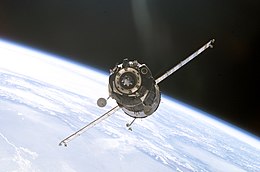 TMA-1 approaches the ISS | |
| Mission type | ISS crew transport |
|---|---|
| Operator | Russian Space Agency |
| COSPAR ID | 2002-050A |
| SATCAT no. | 27552 |
| Mission duration | 185 days, 22 hours, 53 minutes, 14 seconds |
| Orbits completed | ~3,020 |
| Spacecraft properties | |
| Spacecraft | Soyuz-TMA-1 11F732 No. 211[1] |
| Spacecraft type | Soyuz-TMA |
| Manufacturer | Energia |
| Crew | |
| Crew size | 3 |
| Launching | Sergei Zalyotin Frank De Winne Yury Lonchakov |
| Landing | Nikolai Budarin Kenneth Bowersox Donald Pettit |
| Callsign | Yenisey |
| Start of mission | |
| Launch date | October 30, 2002, 03:11:11 UTC |
| Rocket | Soyuz-FG |
| Launch site | Baikonur, Site 1/5 |
| Contractor | Progress |
| End of mission | |
| Landing date | May 4, 2003, 02:04:25 UTC |
| Landing site | Kazakh Steppe (49°37′47″N 61°20′36″E / 49.62972°N 61.34333°E) |
| Orbital parameters | |
| Reference system | Geocentric orbit |
| Regime | Low Earth orbit |
| Perigee altitude | 387 km (240 mi) |
| Apogee altitude | 395 km (245 mi) |
| Inclination | 51.63° |
| Period | 92.4 minutes |
| Epoch | 6 November 2002[2] |
| Docking with ISS | |
| Docking port | Pirs nadir |
| Docking date | 1 November 2002, 05:01:20 UTC |
| Undocking date | 3 May 2003, 22:43:00 UTC |
| Time docked | 183 days, 17 hours, 41 minutes, 40 seconds |
 Launching mission insignia  Launching crew, from left: De Winne, Zalyotin and Lonchakov | |
Soyuz TMA-1[a], also catalogued as Soyuz TM-35, was a 2002 Soyuz mission to the International Space Station (ISS) launched by a Soyuz FG launch vehicle with a Russian-Belgian cosmonaut crew blasted off from the Baikonur Cosmodrome in Kazakhstan.[3] This was the fifth Russian Soyuz spacecraft to fly to the ISS. It was also the first flight of the TMA-class Soyuz spacecraft.[4] Soyuz TM-34 was the last of the prior Soyuz-TM spacecraft to be launched.
- ^ McDowell, Jonathan. "Launch Log". Jonathan's Space Page. Retrieved 9 November 2013.
- ^ McDowell, Jonathan. "Satellite Catalog". Jonathan's Space Page. Retrieved 9 November 2013.
- ^ Quest.NASA.gov Space report No.46 Archived 2008-09-17 at the Wayback Machine
- ^ RussianSpaceWeb.com: Soyuz TMA-1
Cite error: There are <ref group=lower-alpha> tags or {{efn}} templates on this page, but the references will not show without a {{reflist|group=lower-alpha}} template or {{notelist}} template (see the help page).